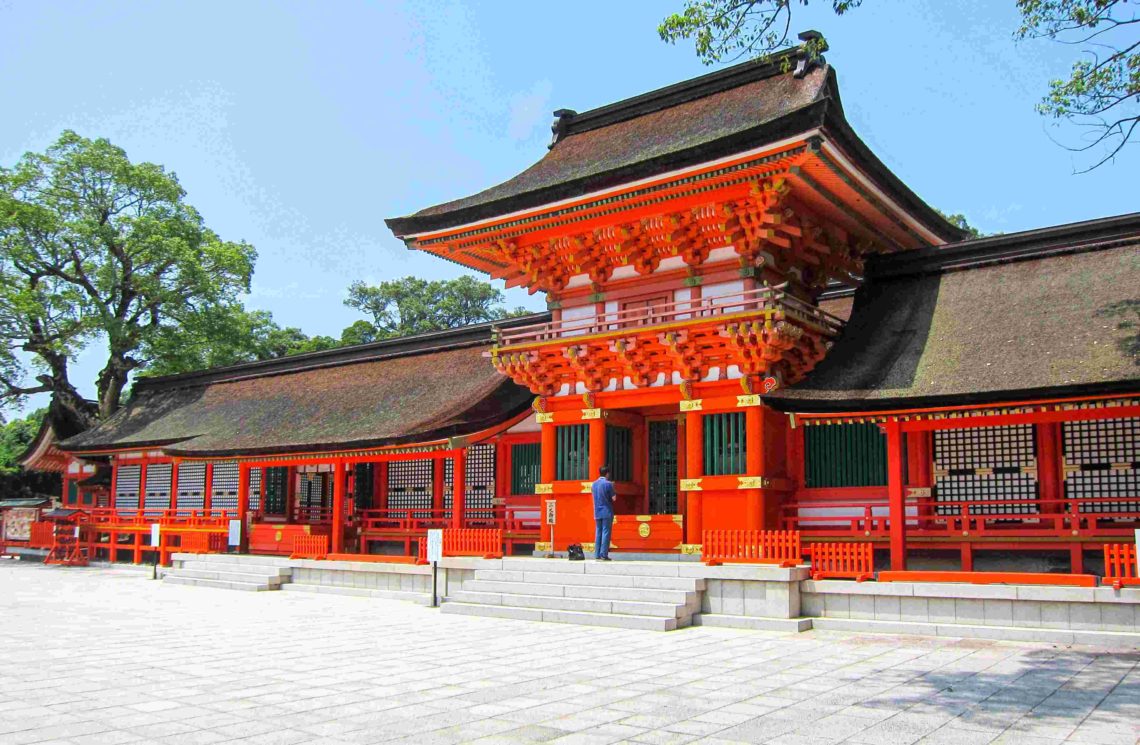
Usa Jingū – A Complete Travel Guide to Japan’s First Hybrid Shrine
What happens when two religions agreed to a mythical crossover? The result is Japan’s first ever hybrid shrine Usa Jingū/Usa Shrine (宇佐神宮), with a grandeur of a palace, but also having a commonly mispronounced name.
Usa Jingū is Japan’s first shrine that represents a fusion between two of Japan’s major religions; Shintoism (神道) and Buddhism (仏教). Located in the North-Eastern Kunisaki peninsula (国東半島) of the island of Kyushu (九州), it is nestled in a rural town called Usa (宇佐), Japan; one of the reasons why this shrine is outside of tourist radar despite being a long-established shrine.
So is this shrine worth the time and effort to travel? Let’s explore deeper into it.
Table of Contents
History
Built in the 8th century during the short but impactful Nara period (Nara jidai/奈良時代); the shrine has a distinguished record of being the first case of project collab between Shintoism (神道) and Buddhism (仏教). The result is a shrine that incorporates a unique crossover of architecture from both religions.
Usa Jingū furthermore pioneered the Hachiman shrines (八幡宮) worship Hachiman (八幡); which eventually expanded throughout the history of Japan to an astounding 44,000 shrines. The deity Hachiman (八幡) is the God of War and Archery in Shintoism; whom eventually became a god in Buddhism too.
Because of its significance, it was often embroiled into various political scandals with the Imperial Court and samurai (侍) warlords. For example during the 16th century, a Christian warlord divorced his wife (a staunch Buddhist); and he eventually waged a war against her on the grounds of the shrine.
Later in the 19th century Meiji Era (明治時代), the government forced it to eradicate its Buddhist elements due to the controversial Shintoism-Buddhism separation order at that time. Nevertheless, the government eventually recognised its prestige and conferred it the title of National Treasure. This is because of its unique Shinto-Buddhism architecture known as the Hachiman-zukuri (八幡造), being one of the last few surviving testaments in the country.
Usa Jingū is a testament of how a passion project between two religions can transform into a conglomerate like Apple, Microsoft and Toyota (トヨタ). Yet it still manages to stay humble and hidden. Keen in exploring further? Continue reading to find out. Or if you are a history buff, check out the Usa Jingū history series links below:
Exploring Usa Jingū
Located deep within the countryside town of Usa (宇佐), Usa Jingū is built atop a hill while being surrounded by the serene forest. To praise the shrine alone for its grandeur and high-ranking status would be an understatement to say the least; as the shrine is a great example of how one can be prestigious and humble in the same time. If there is a shrine that assimilates perfectly with nature while giving you the precious quiet time to explore, look no further to this shrine.
Interested in exploring this unique shrine? Then, click on the below sections to find out more.
- Firstly, look out for the shrine’s entrance.
- Secondly, make your way into the shrine’s inner compound.
- Check out these lovely photo spots.
- And even more wonderful sceneries awaiting to be snapped.
- Afterwards, check out the shrine’s main complex.
- If you are curious what’s inside the complex.
- In case you are an explorer, check out these hidden attractions.
- Finally, don’t forget to check this gem before leaving.
Entrance to Usa Jingū
For starters, we will encounter the main gate or Torii (鳥居) of the shrine; a simple and large structure, coloured mainly with vermillion and a bit of black. Do you notice the two black rings at the top and the uppermost black coloured pointy roof? These features signify the shrine has a much higher rank compared to other shrines in Japan, being the founding shrine of worshiping Hachiman (八幡).
Believed it or not, the gate also has a name and its called ‘Usa Torii (宇佐鳥居)’; a style unique to this shrine that it doesn’t need a signboard like other shrines to display the name. Subsequently, it became popular that it served as an inspiration for Toriis of other high-ranking shrines in the country, including the renowned Fushimi-Inari Taisha (伏見稲荷大社) in Kyoto (京都).
Continue walking and you will eventually pass by a few black locomotive trains that once connected Usa to other parts of Japan in the 19th century. These were the actual train models and had served on the railway for 71 years before being decommissioned and preserved with the help of the Lions Clubs in Kyushu. While they seem off place located in the vicinity of a 1000 years old shrine, they exude off a lovely nostalgic vibe and give you a rough idea of what 19th century Japan is like.
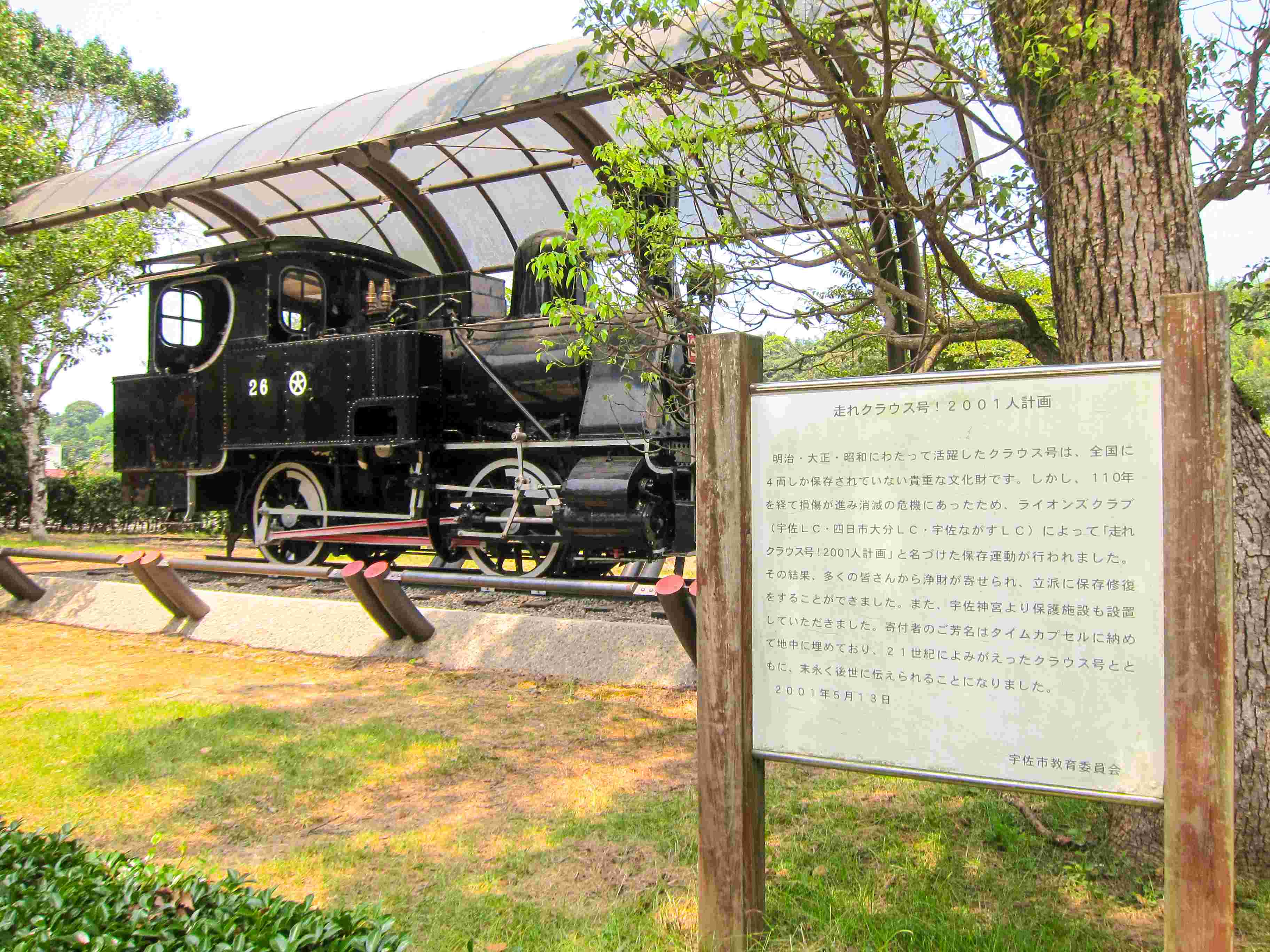
Along the Way to the Shrine
Cross the vermillion bridge and walk straight until you see a spacious complex with a path leading into the forest. I attempted this on mid-summer of Japan, where the heat wave was insane, and temperatures reach up to 40 degrees Celsius. Until you reach the center of the shrine, there are literally no shades other than the natural shades from the forest.
If you are attempting on summer, I would advise bringing a cap or an umbrella with some comfortable clothing to wear. Or else you will be melting like an ice-cream like me. Alternatively, you can visit on spring (March to May) and autumn (September to November) when the weather is much cooler.
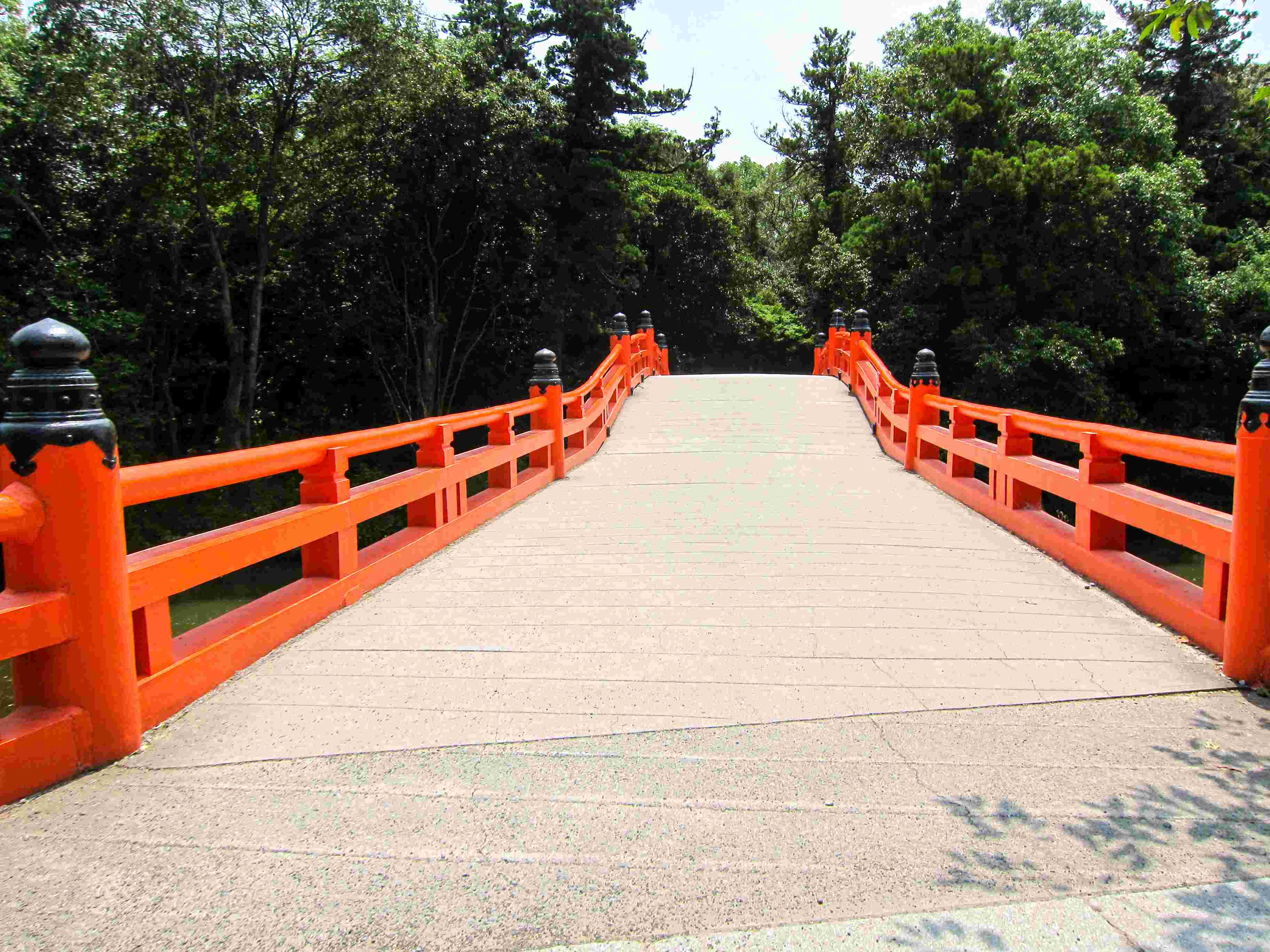
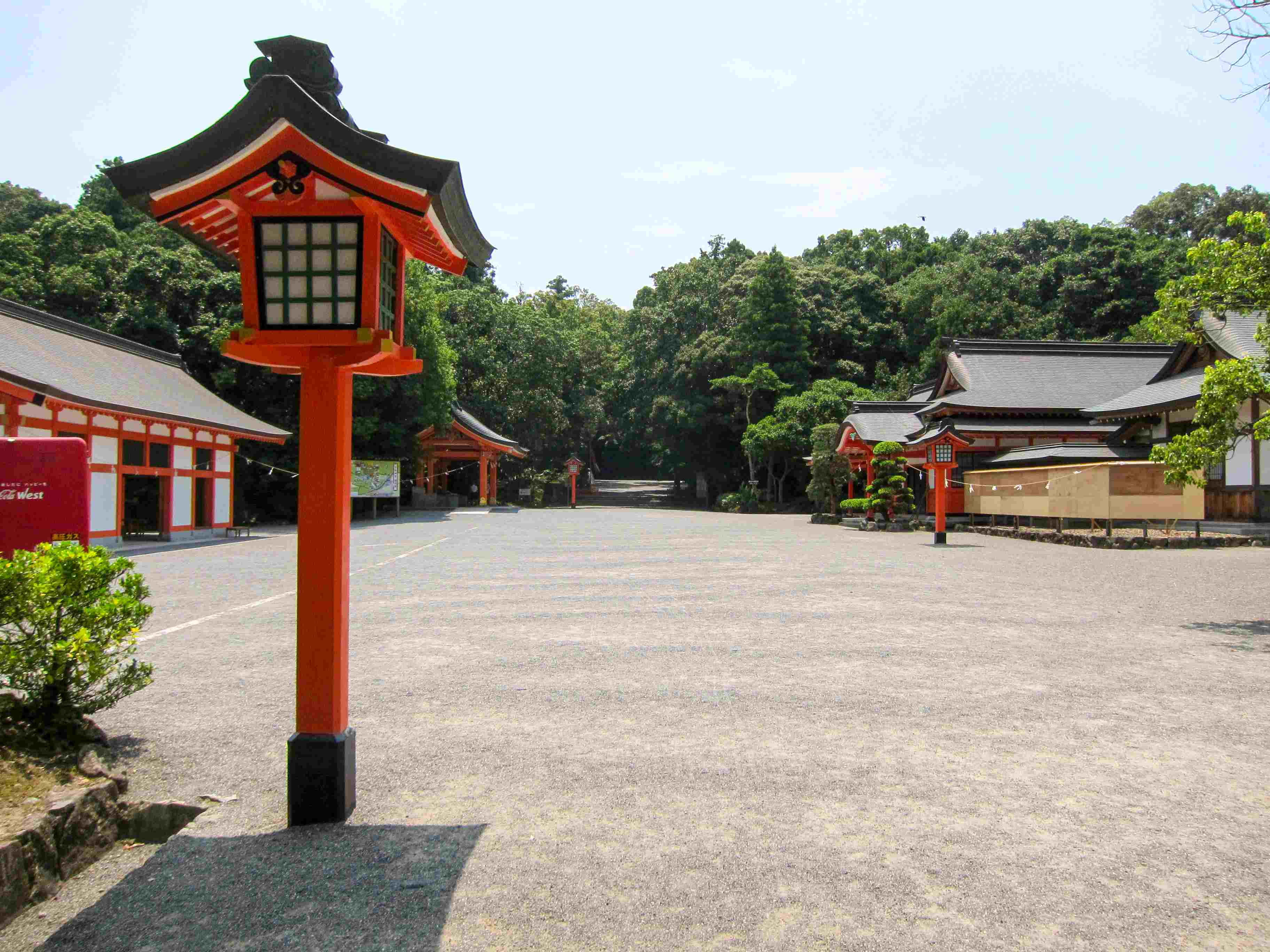
Look! Lovely Photo Opportunities Around Usa Jingū
Head towards the path into the forest and that’s where the main course begins. The complex lies within a forest, and the vermillion coloured structures provide a strong contrast with the lush forest. A lot of Shinto shrines are commonly built within or next to forests; as they believe in the worship of nature and every elements of the forest has an individual deity. For example, the mountains have their own respective deities and so does the rivers, forests etc.
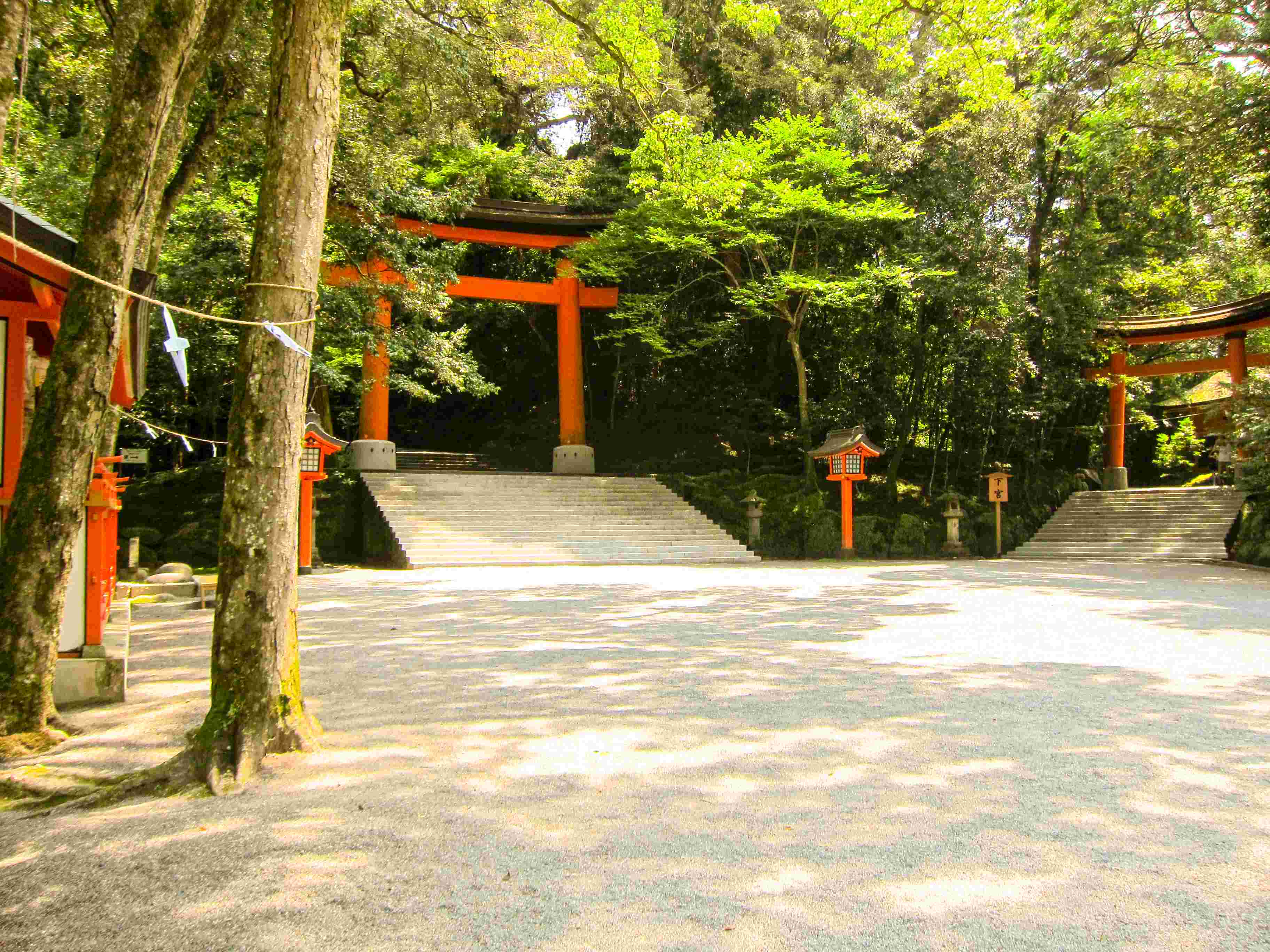
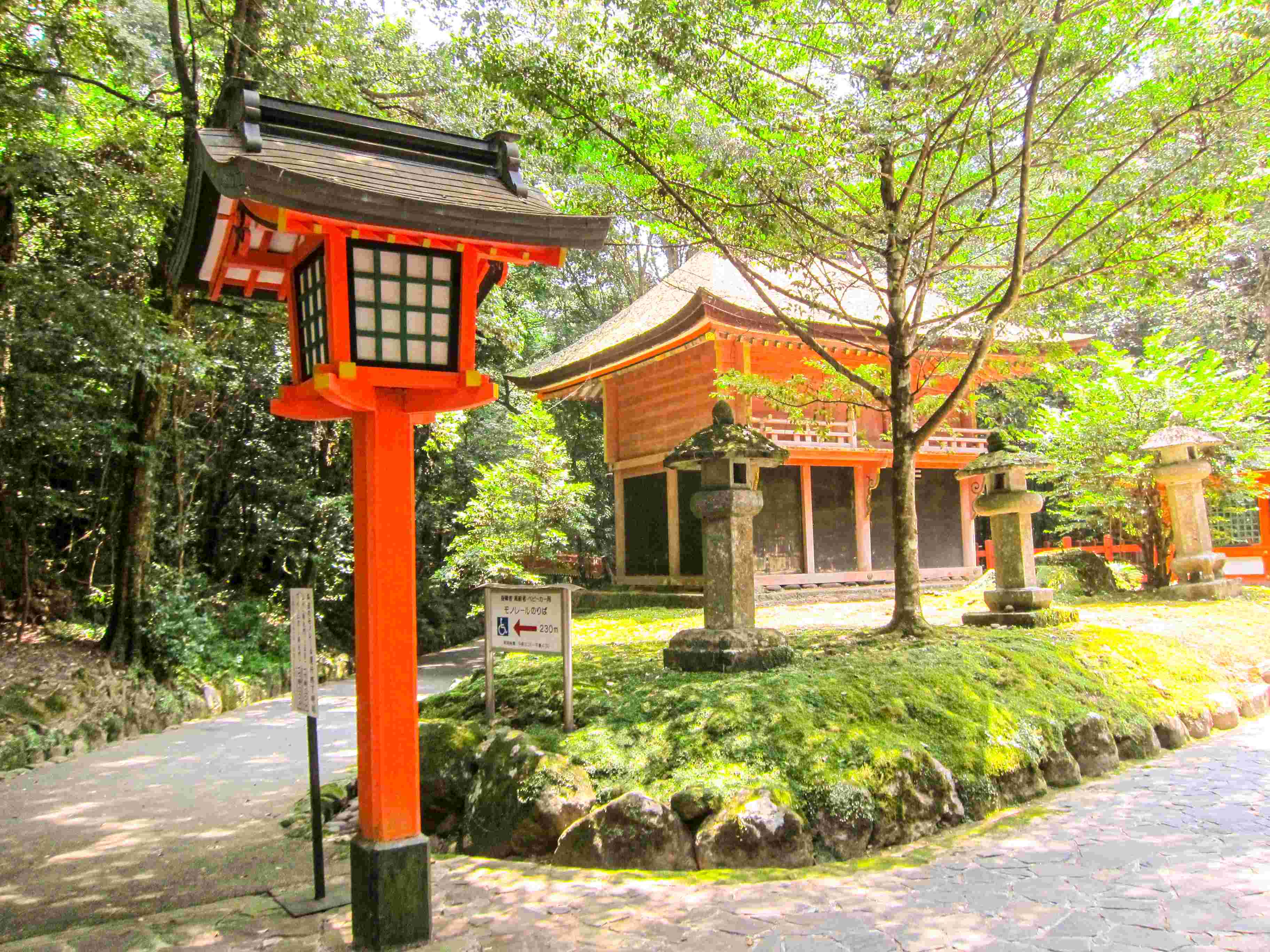
While the forest is a nice shade from the blazing hot sun, it also creates a mesmerising scenery together with the vermillion structures and the sunlight. I personally love to take my time to admire the beauty of the integration between mother nature and the man-made structures here. It’s so natural and surreal, that it makes you feel like you have been transported into the spiritual world. Get ready your cameras and smartphones as there are lots of opportunities for wonderful photos in this area.
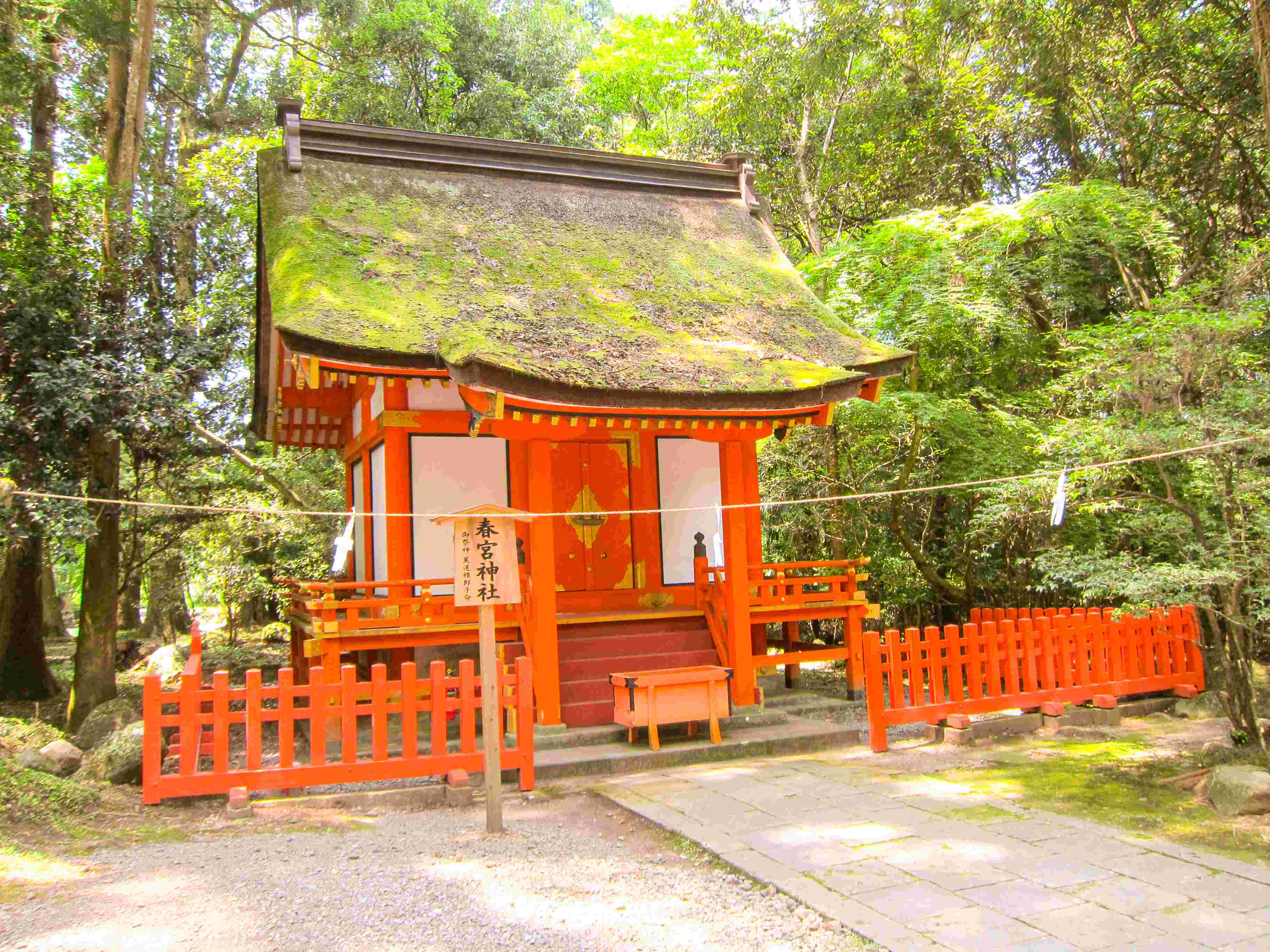
We Are Almost There
The stone stairways are lovely; especially when they are shaded by the serene forest and accompanied by these little vermillion lanterns. Walking along these stairs feels like going through a spiritual path that will soothe the heart; undeniably something that I needed desperately after walking under the blazing sun for the past 20 minutes. Moreover, this is a great spot for more lovely photo opportunities, especially for the nature lovers.
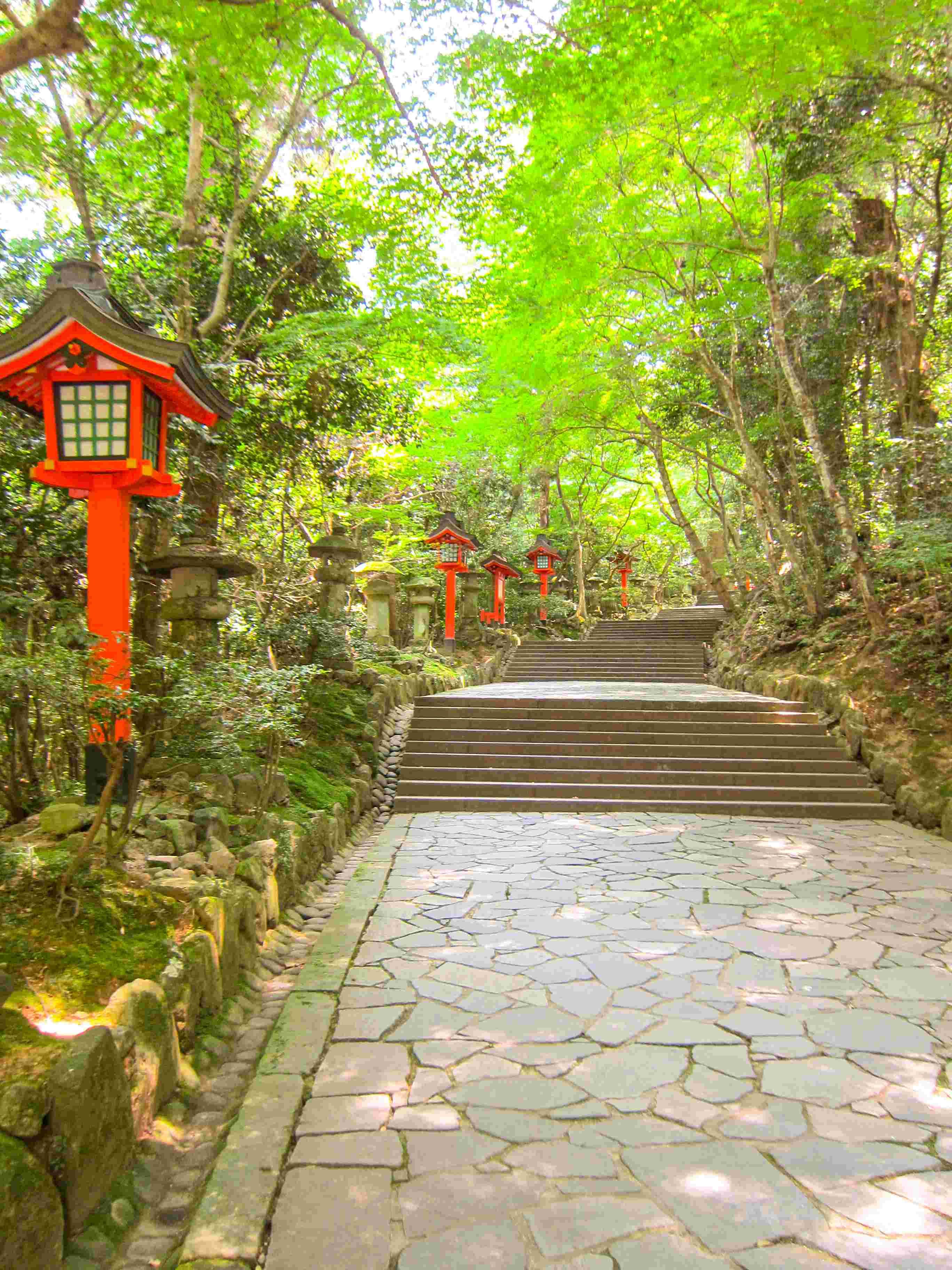
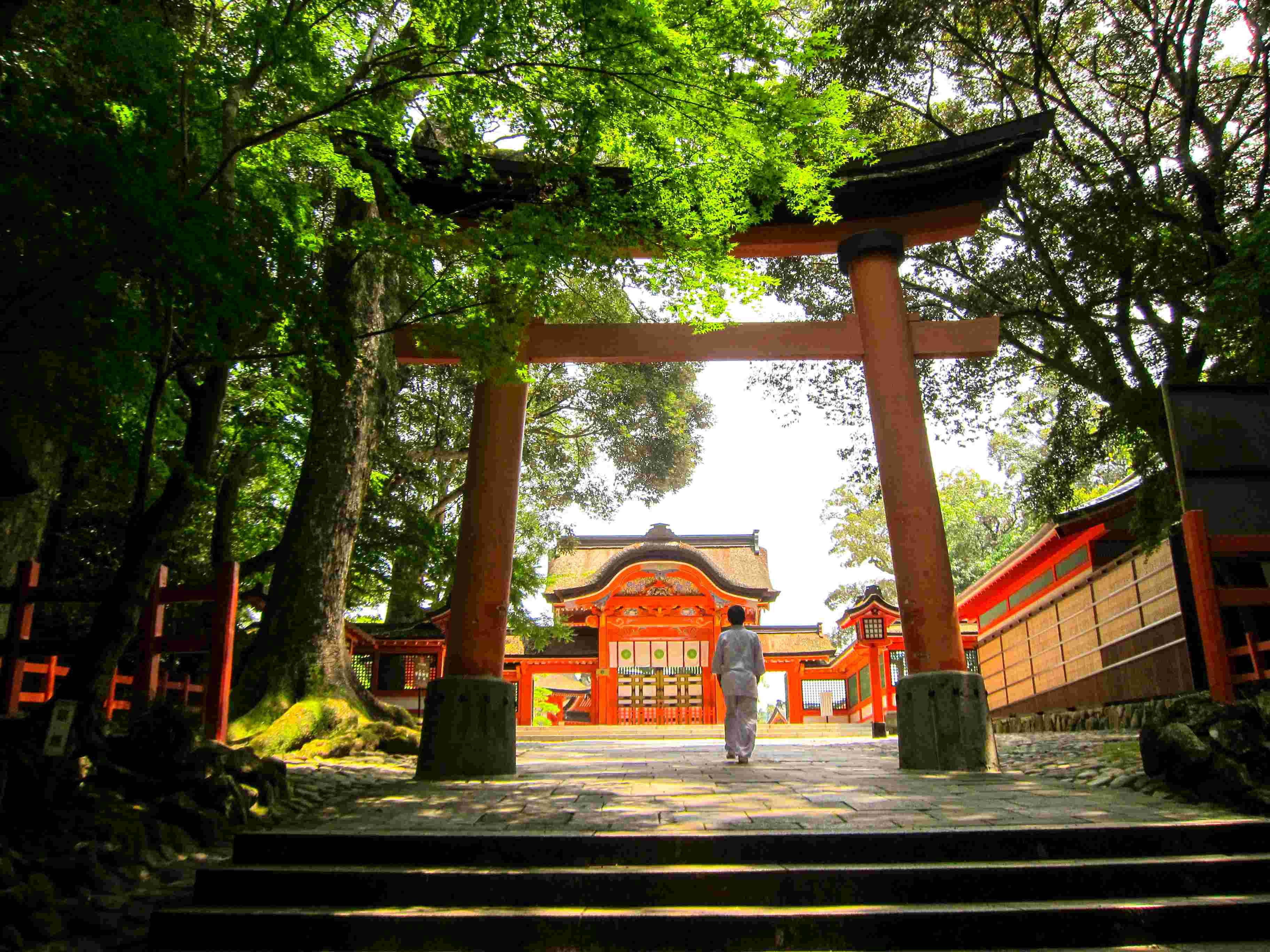
You can’t miss the entrance of the shrine; the striking and beautifully ornamented Saidaimon Gate (西大門), literally means Large Gate of the West. This gate was built in 1592 and is an actual designated National Treasure for the shrine. The middle door is labelled with chrysanthemum emblems, which means the door is strictly reserved for Imperial family members and envoys only.
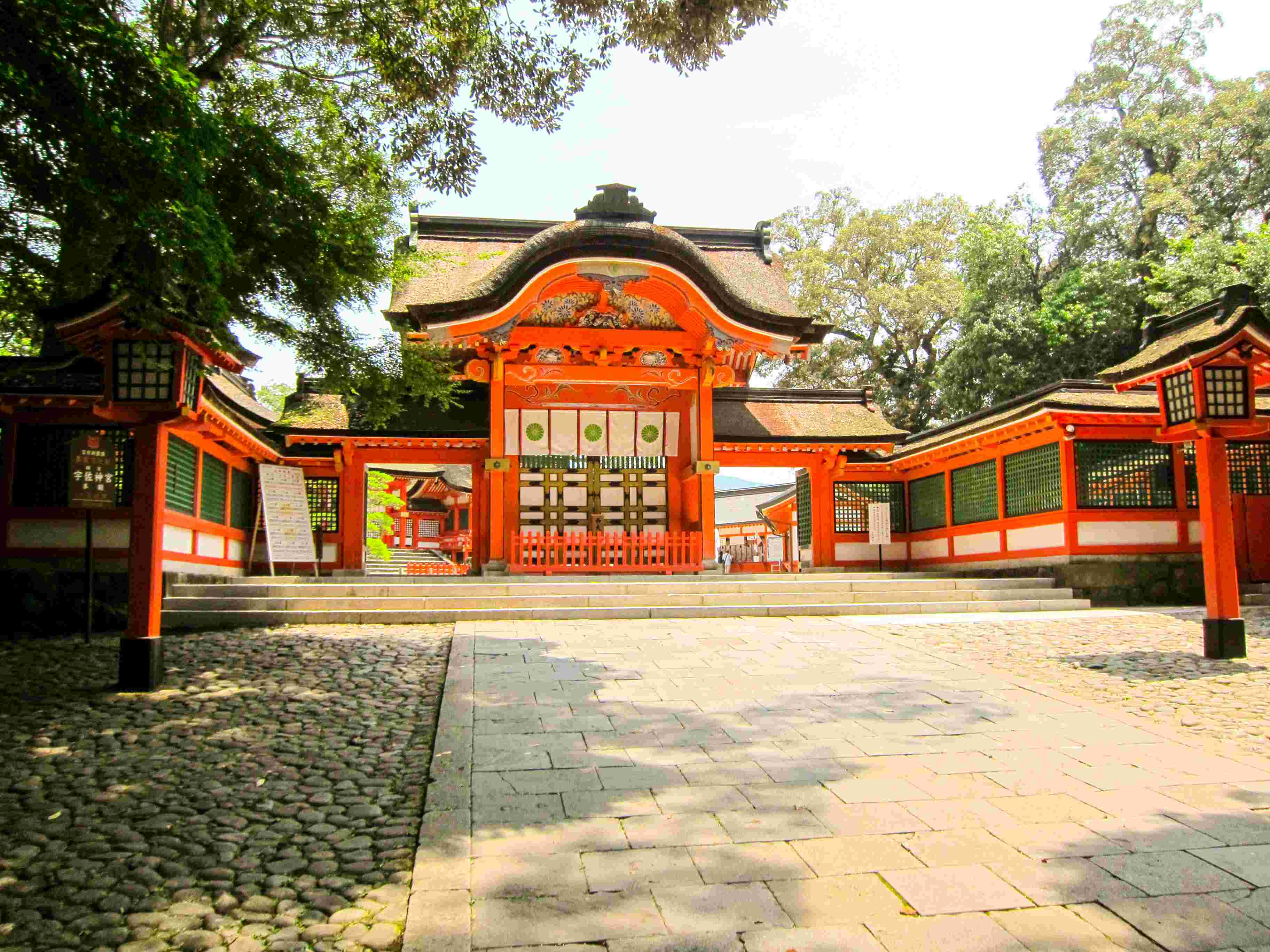
The Main Complex of Usa Jingū
Walk for a couple of minutes and eventually, we arrive at the graceful and gorgeous main complex of the shrine, or Honden (本殿). This gate below is the Chokushimon (勅使門), translates as the Gate of the Imperial Emissaries as well as the poster boy of Usa Jingū. Prayers are done in front of this complex.
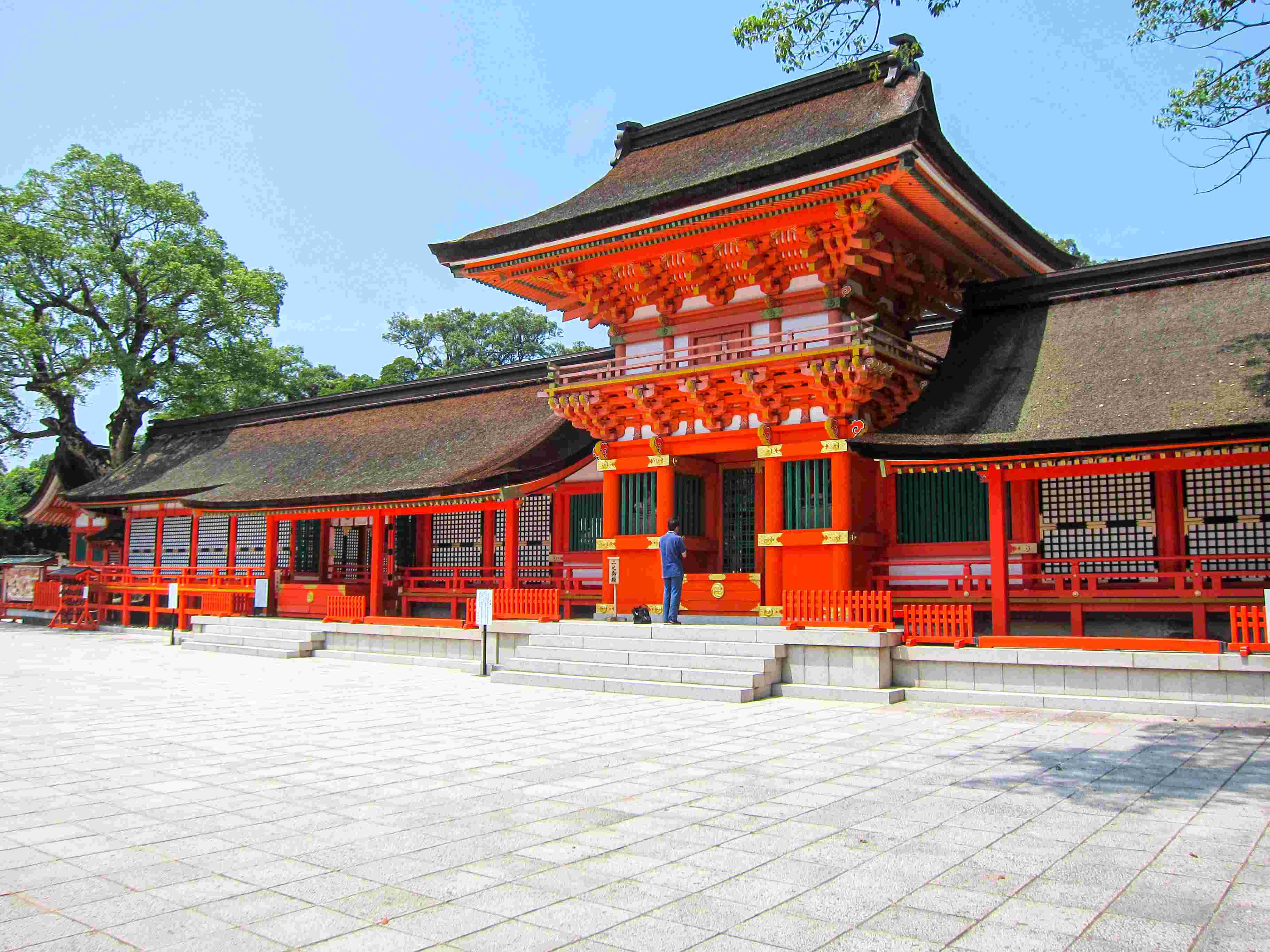
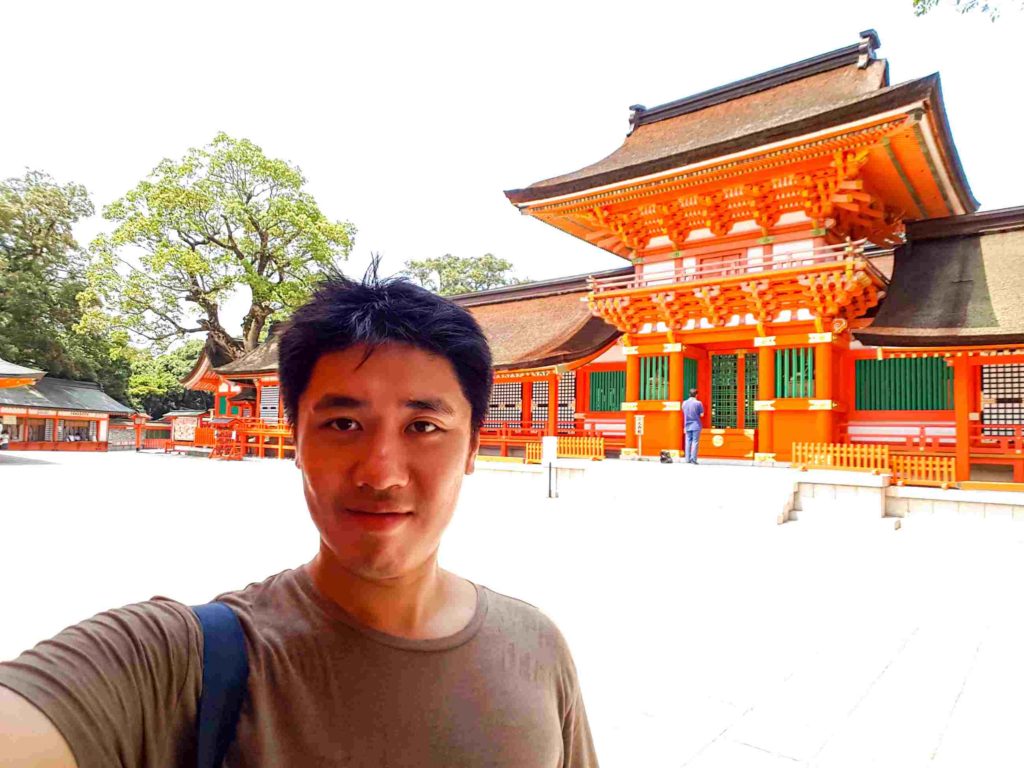
Usa Jingū is also one of the last surviving testaments to feature a unique architecture that contributed to its National Treasure status. For the architecture lovers, click on the below section to learn more about it.
The Hachiman-zukuri (八幡造) is a style where one building is built to resemble two separate buildings from the side, with each part having its own roof. This concept originated from the Buddhist temples and is known as Narabidou (双堂), the front portion housing the worship hall and the back is reserved for the Buddhist monks only.
This style was cleverly incorporated and tailored according to Shintoism beliefs. Worshippers believed that the front hall is for the Gods to greet them during the day and the back is their bedroom. The below picture shows what the building looks like from the side. Additionally, pay close attention to how the two roofs create an illusion of two separate building, while a small corridor in the middle combines both portions.
Today, the architecture remains a legacy of how two religions can integrate their beliefs and coexist peacefully. Credits to Urashimataro for the image below.
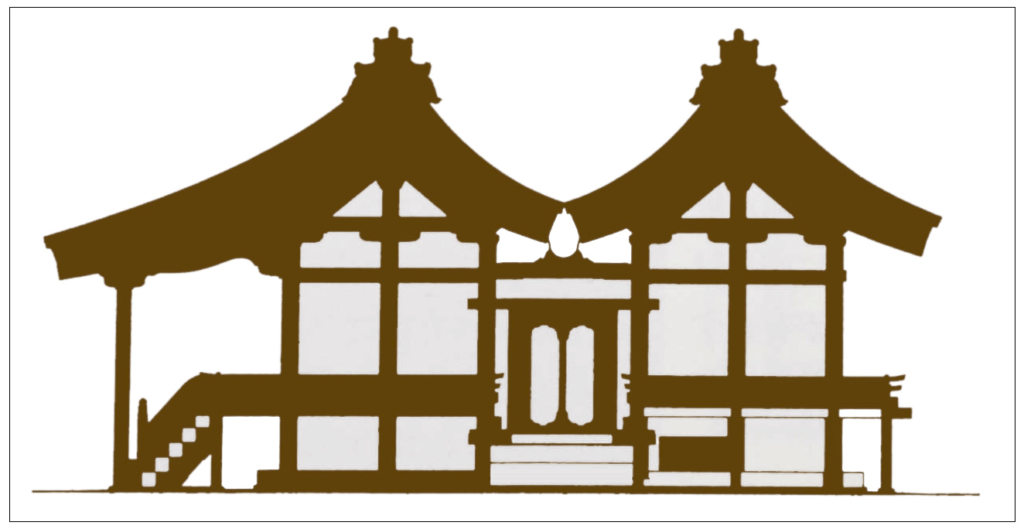
Inside The Shrine Complex
The main chambers are locked away beyond the gate from the public since the inception of the shrine. This is to maintain the purity and sacredness of the complex. However, you can peek through the frames to get a glimpse of the inner compound. Imagine what it was like for commoners in ancient times to snag a chance to peek into the shrine’s inner compound. It must have been a real golden opportunity for them given the shrine was once guarded by armed warriors.
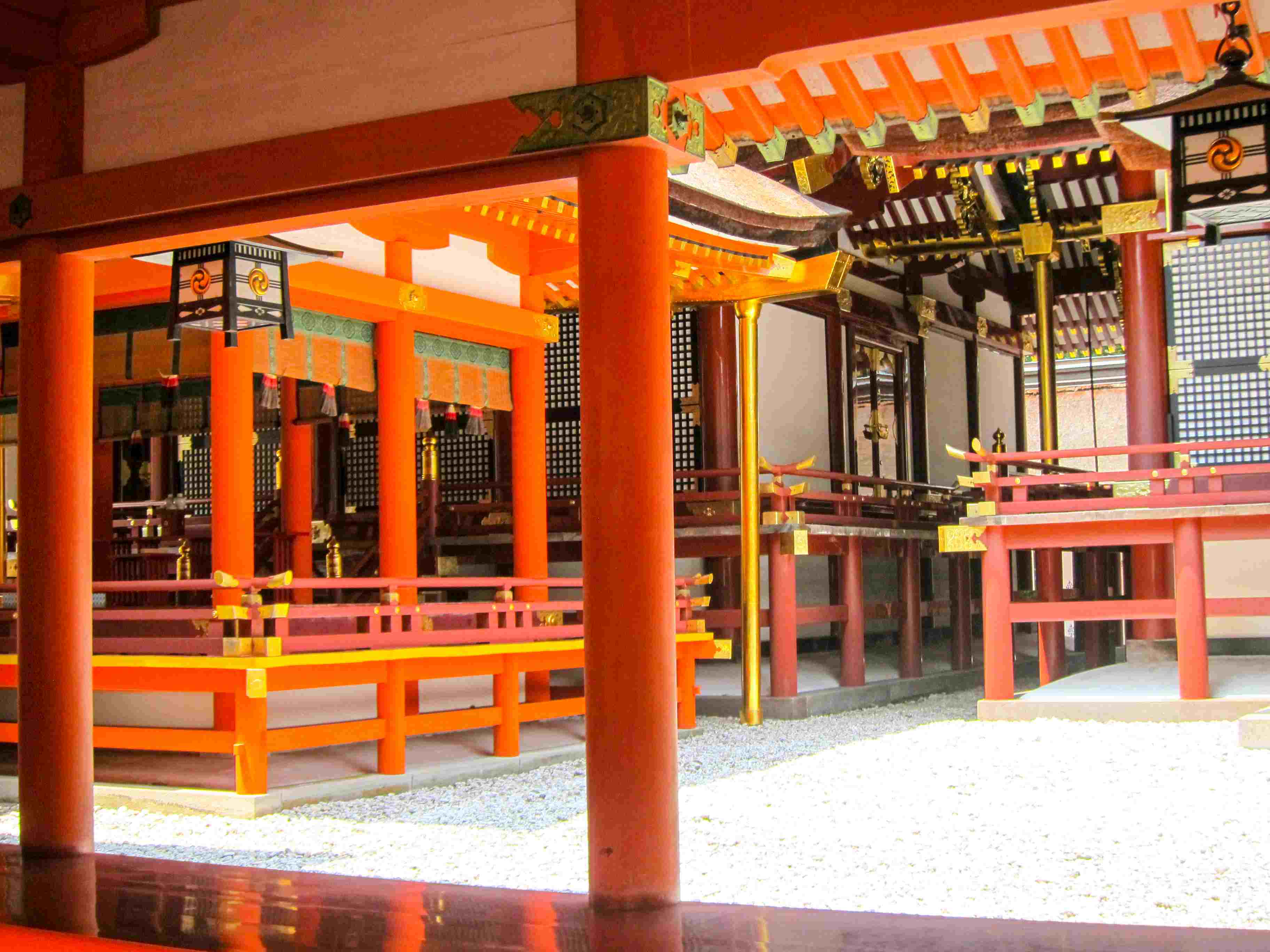
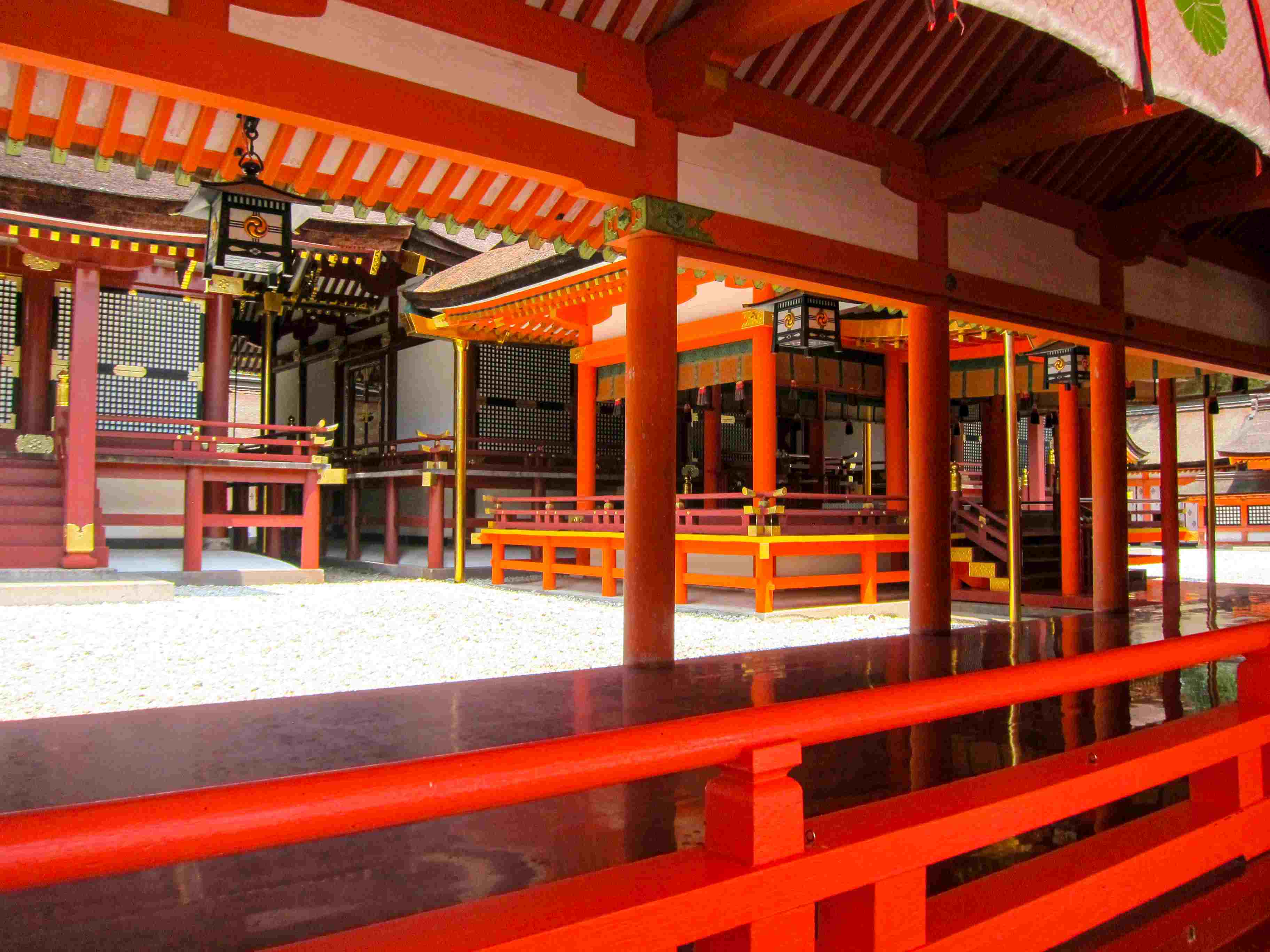
Furthermore, the complex contains three chambers which houses a total of three Shinto (神道) deities including Hachiman (八幡) himself. Check out below for more info and also on how to pray:
Hachiman (八幡) – God of War and Archery, worshipped specifically by those who are going for competitions.
Himegami (比売神) – Hachiman’s wife and Goddess of Business, worshipped specifically by the business and career-driven.
Empress Jingu (神功皇后) – Hachiman’s mom and Goddess of Birth and Family, worshipped specifically by families and couples wanting babies.
- Firstly, stand in front of the main shrine.
- Throw a coin into the coin box. Any coins are fine, but the best would be the 5 Yen coins as Go-en (五円) means good luck.
- Next, clap 4 times with your arms.
- Then, pray and bow deeply.
- And finally, step back and bow again lightly without showing your back to the Gods.
Don't Miss Out on the Smaller Attractions
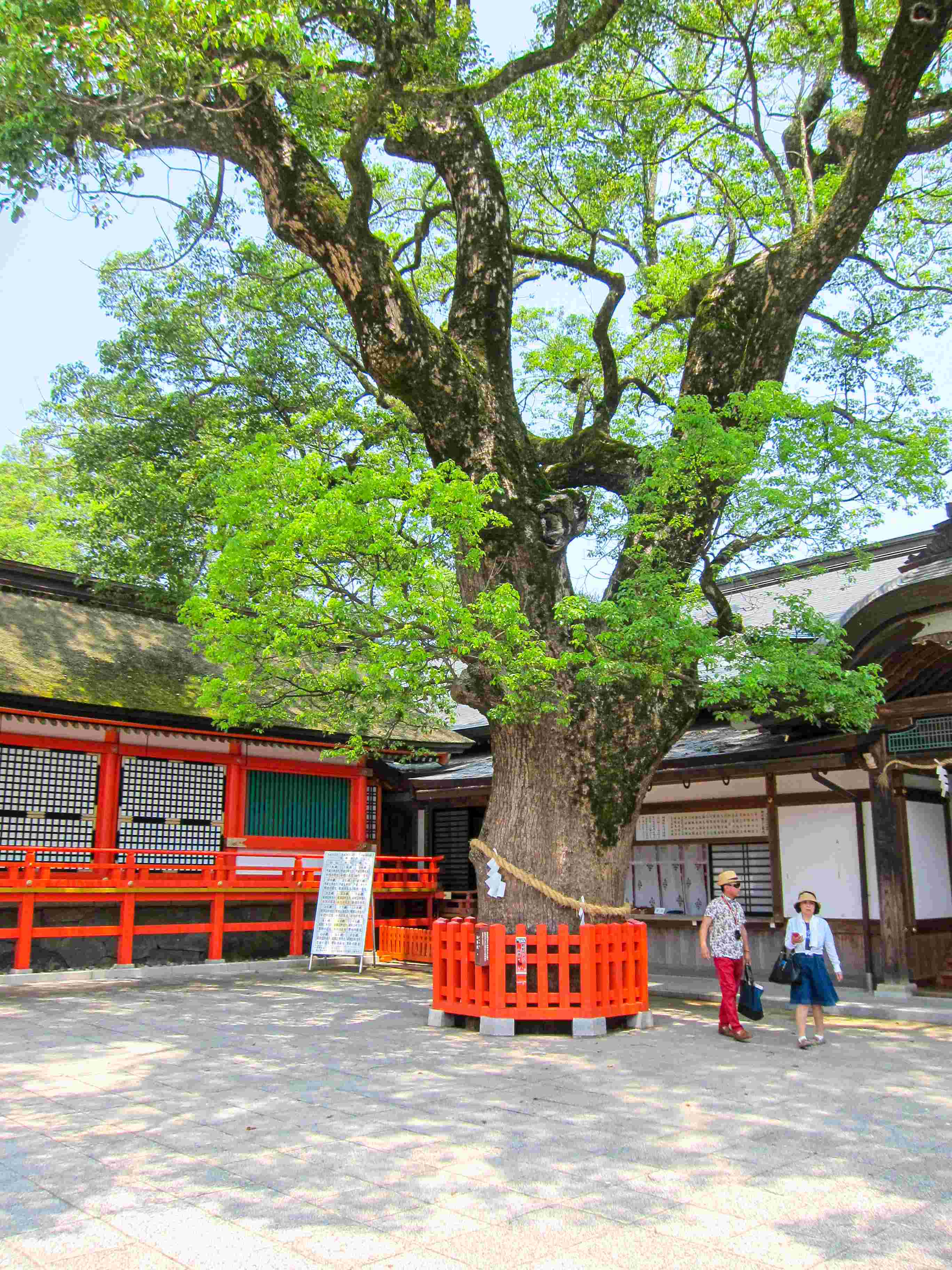
Around the shrine complex, there is a section where small wooden plaques are left hanging on a board. These are called Ema (絵馬), where you can write your wishes on it and hang it at the shrine for the Gods. They usually come in pictures of a horse or a Chinese zodiacs animal. In my case there were plenty of monkey ones because it was the year of the monkey at that time.
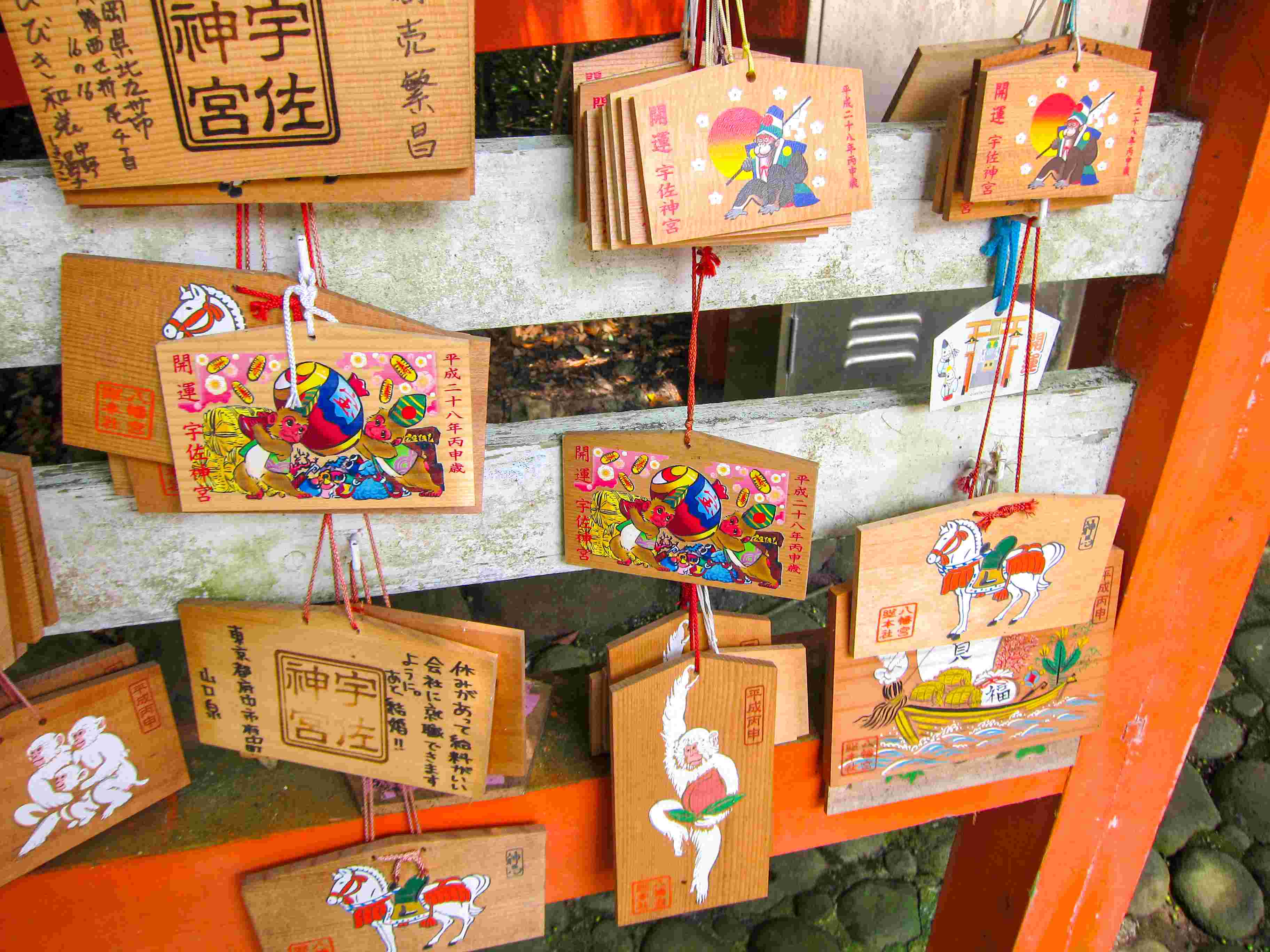
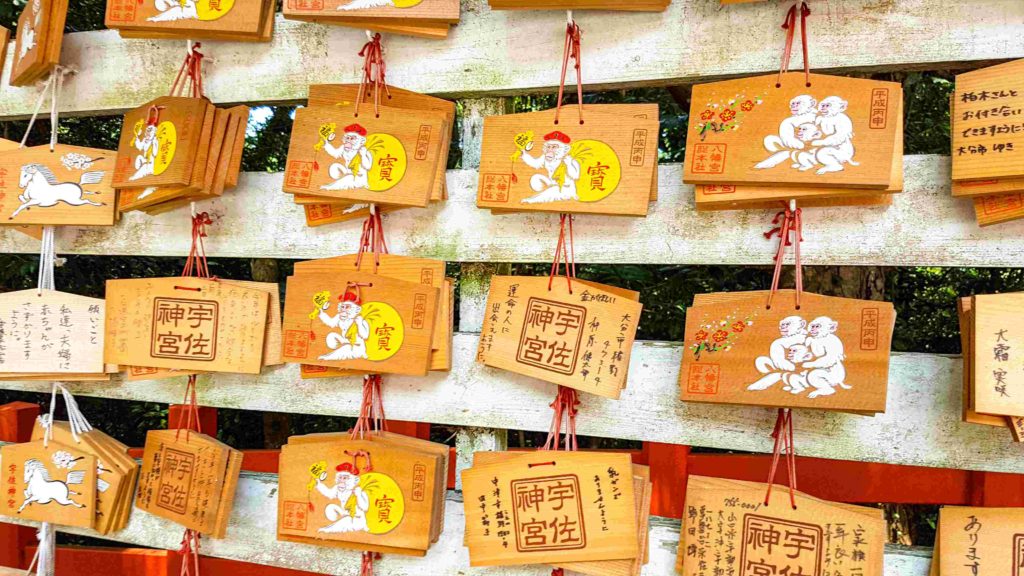
Afterwards, head down back to the entrance and stop by the Lower Shrine (Gegū/下宮) at the foot of the hill, a smaller version of the upper complex housing the same three deities built in the 9th century. Locals usually come here to pray for good harvest. While not as impressive as the main shrine, I enjoyed its reclusiveness and serenity that it provides to relax after hiking the hill.
As We Leave Usa Jingū
Right before you exit the complex, don’t forget to check out the fascinating Kurehashi (呉橋) bridge. It is another of my personal must-see spot aside from the main complex. Considered as one of Japan’s top 100 bridges, its roof is made of Japanese Cypress tree barks and was built in the 12th century Kamakura period (鎌倉時代), the beginning of the warrior-class samurai era. Unlike most bridges, this one is designed to be curvy, giving it a very slender look that makes it attractive and outstanding on its own right.
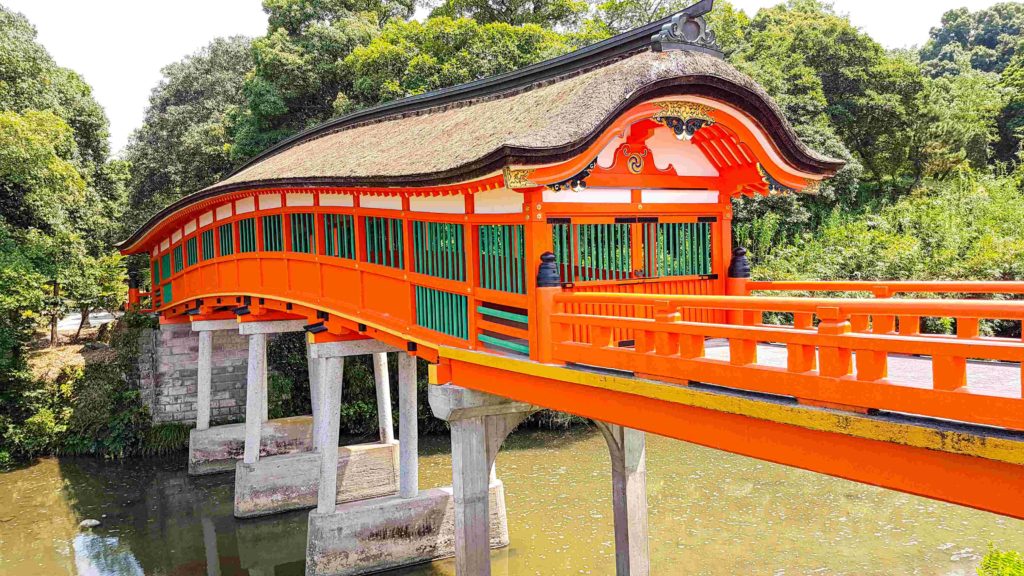
The bridge is normally sealed and only opens once in every 10 years during a ceremony when an Imperial envoy hands a gift from the Imperial Family to the shrine. The envoy must then cross this bridge to hand over the gift to the shrine and complete the ritual. The most recent ceremony was in October 2015 which they allowed the public to cross the bridge before and on the day of the ceremony.
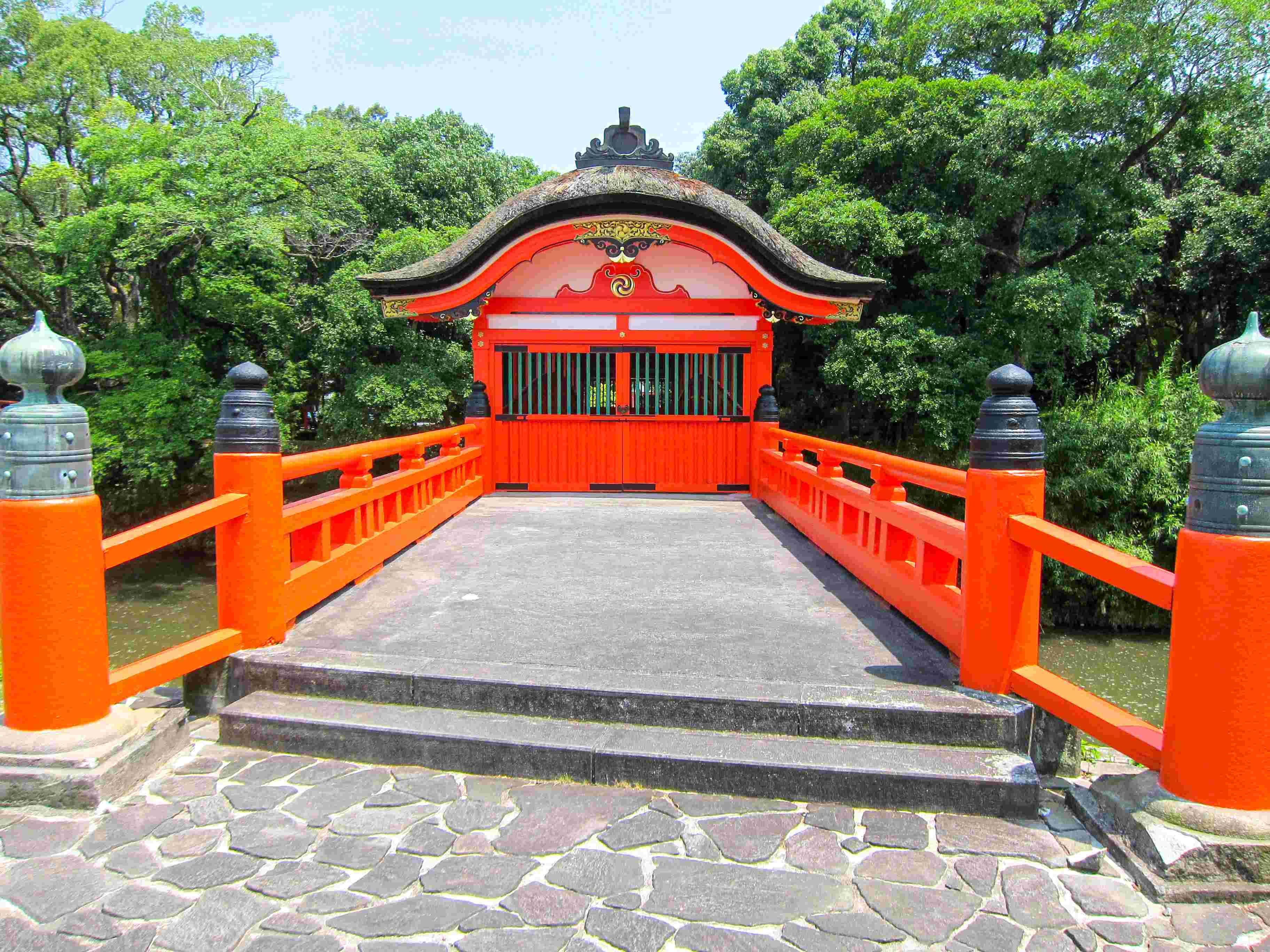
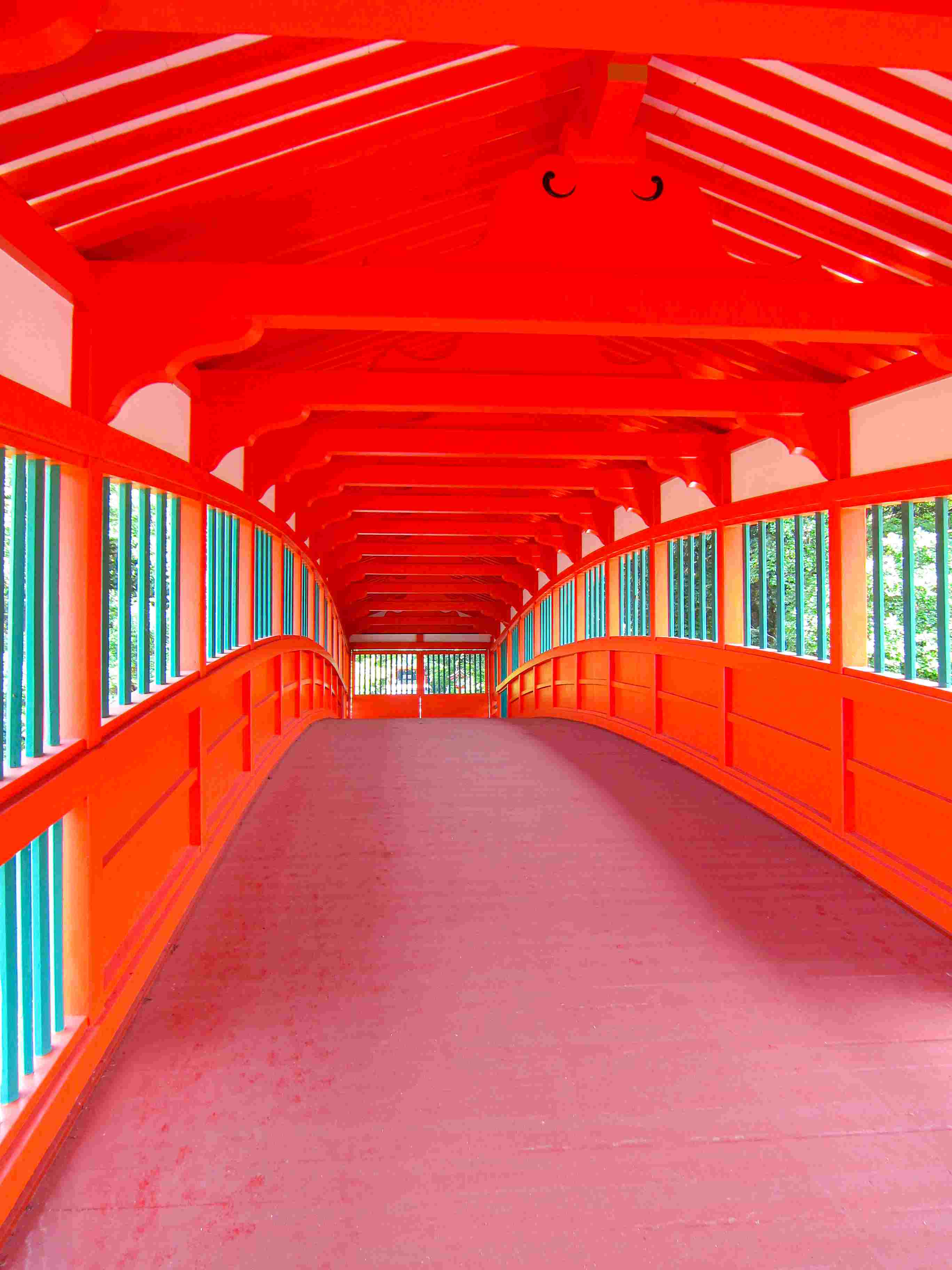
Traveling to Usa Jingū
By Train
The shrine is well connected on the on the Nippō Main Line (日豊本線) by the JR Sonic (JRソニック) train; which you can board easily from other cities in Kyushu. Here is a comparison of estimate ticket prices and duration from the nearby cities.
Editor’s Note:
Travelling via train is very convenient; but can also be very costly and most likely will make up 50% of your travel expenses in Japan. If you are keen in visiting this shrine and other parts of Japan, I would suggest the Japan Rail Pass or JR Pass (ジャパンレールパス); a convenient all-you-can-ride pass that allows you to ride on all JR lines in Japan including the JR Sonic on the Nippō Main Line. A wonderful option especially if you are travelling extensively around the country. Check out the JR main page to learn more of this pass.
To get there, firstly, disembark at Usa (宇佐); lookout for the signboard with the signature Usa Jingū caricature.
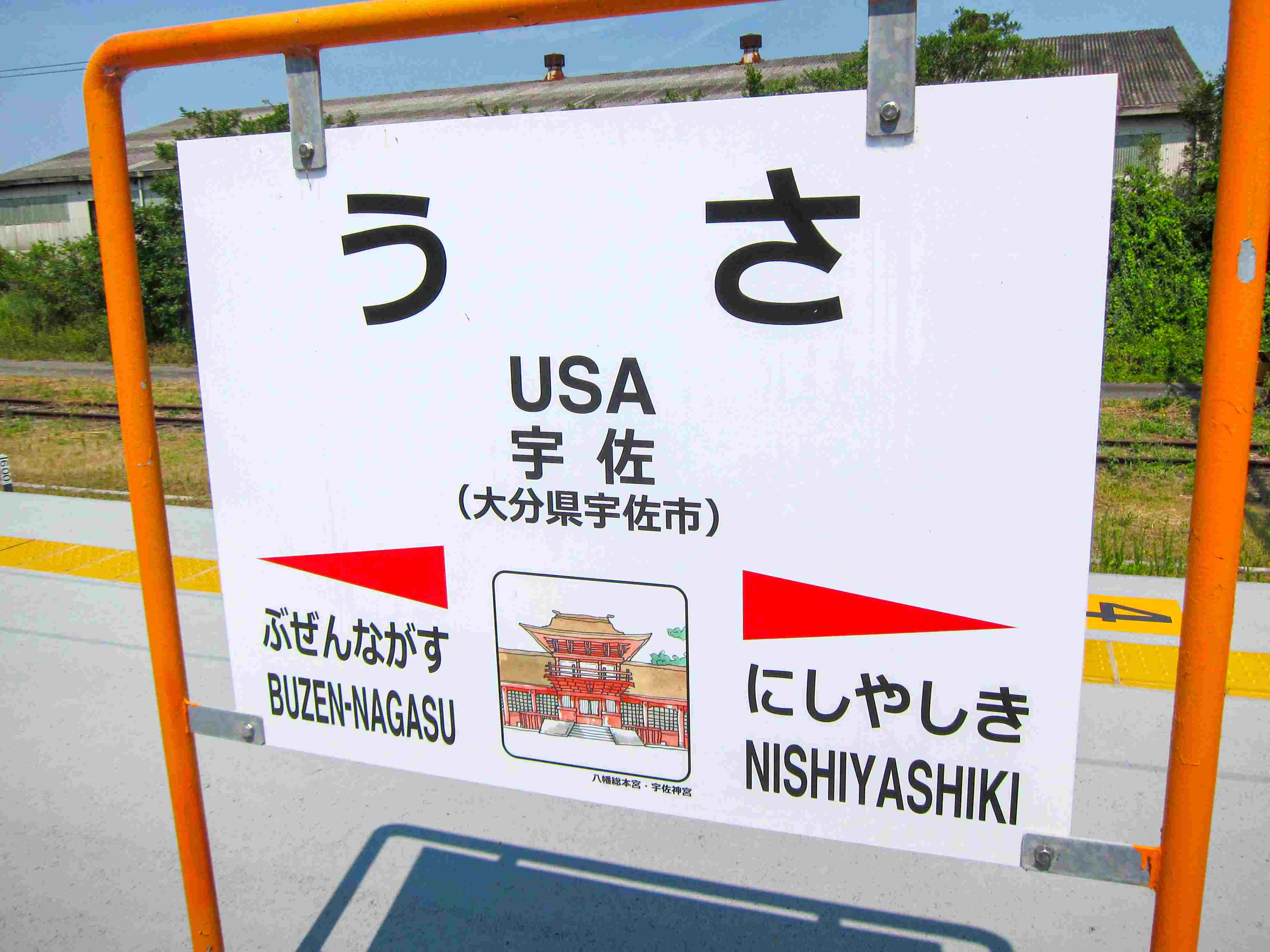
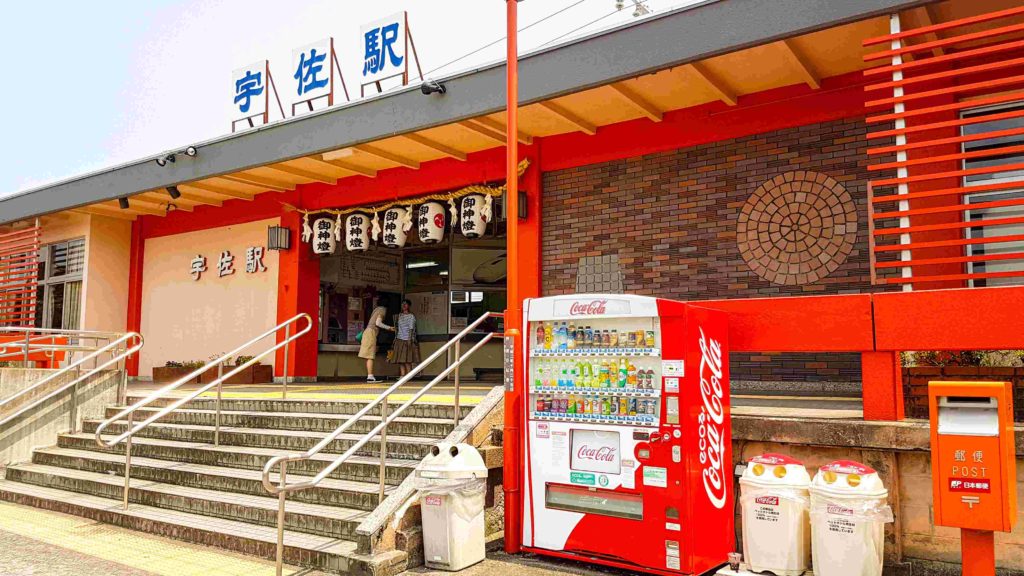
From the station’s entrance, take an hourly bus to Usa Jingū which costs 240 Yen and then, ride for 10 minutes. Afterwards, get down at Usa Hachiman Basutei (宇佐八幡バス停) and look out for the entrance with the huge vermillion gate/Torii (鳥居).
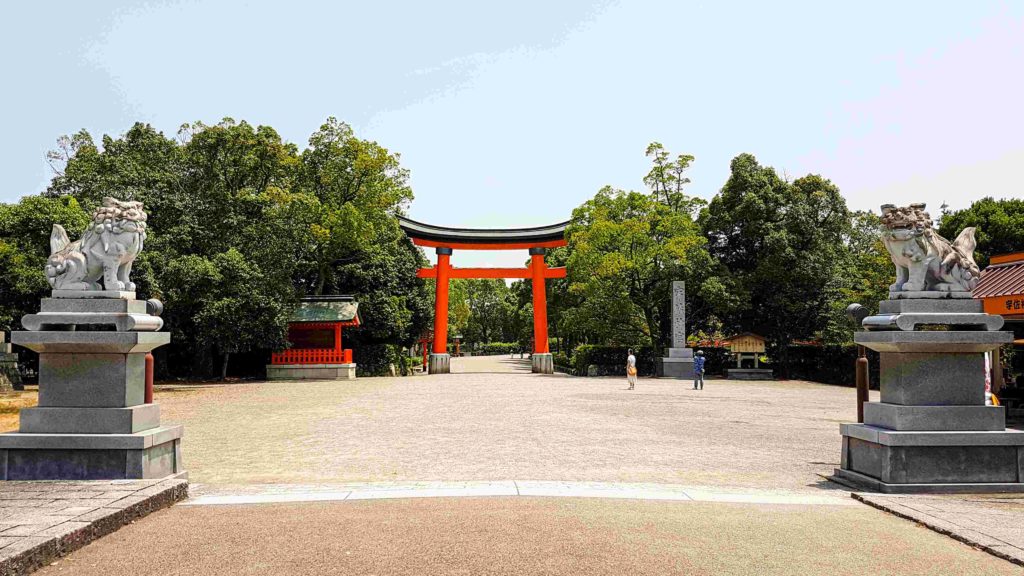
By Car
A great alternative for those who want to explore deeper into the countryside areas and the beautiful mountains of Kyushu. If you think the shrine is the only attraction in Usa, think again as there are some off-radar spots near the shrine that can only be explored via car. These includes:
- Higashi Shiiya Falls (東椎屋の滝): Ranked as one of Japan’s 100 famed waterfalls; known for its spectacular natural scenery and a hidden power spot among locals. Click here for location.
- Stone Bridges of Innaimachi (院内町の石橋): The only town in Japan that holds a collection of 75 charming stone bridges. Click here for location.
- Keishoji Temple Ruins (桂昌寺跡): A village cave temple that takes you on a journey through heaven and hell. Click here for location.
Also, check out my separate article here to discover more beautiful road trip destinations near Usa.
Editor’s Note:
A friend of mine used Tocoo; Japan’s leading rental car website which is reliable and provides a wide selection of cars, ranging from small economical cars to the big family ones with affordable rates. Are you unsure of getting the necessary license and familiarising with the rules of driving in Japan? Fret not as they provide comprehensive guides in their site on what you need to start your driving journey in Japan. Click here to embark on a wonderful journey of driving through the countryside of Japan.
Overall Thoughts
Usa Jingū is undoubtedly a standout among the must-visit shrines in Japan. It is significant from a historical point of view, and yet retains its grandeur and peacefulness for travelers to enjoy in their own leisure. Being located inside a forest is a plus point for nature lovers too while providing an environment where one can escape the city and immerse into the nature.
Loving the content here?
Subscribe and get your free hidden gems in Japan bucket list here.
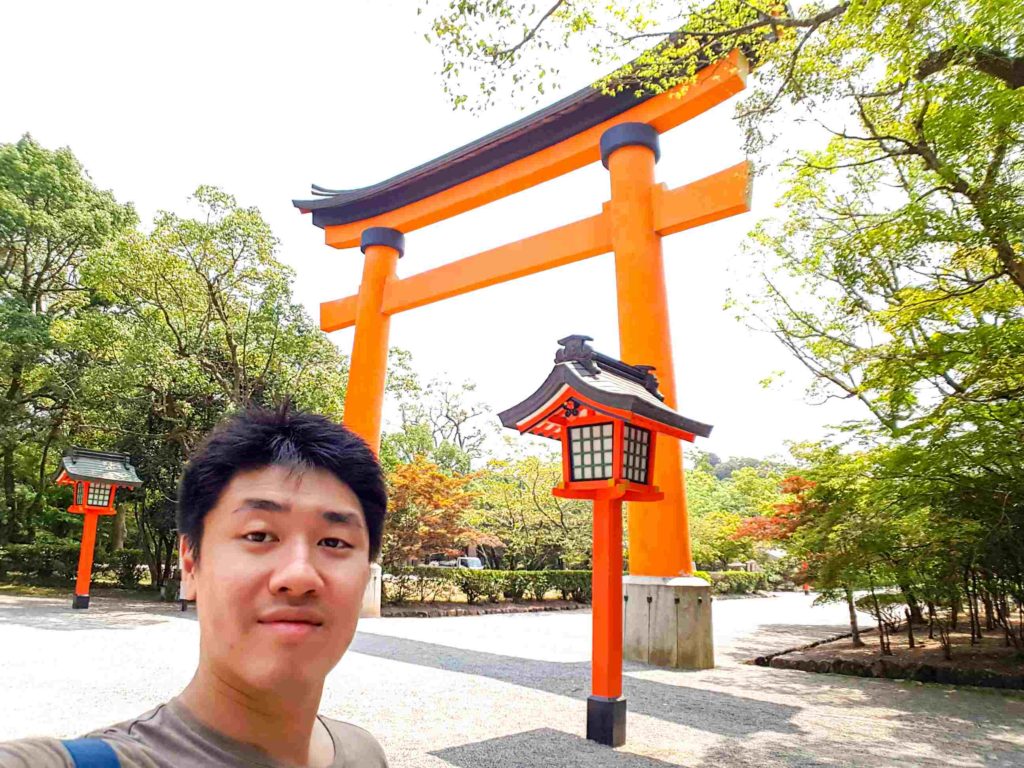


You May Also Like
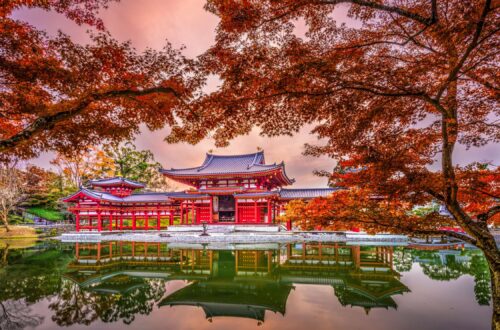
9 Kyoto Day Trip Gems You Can’t Miss: Get The Ultimate List of Panoramic Views
October 19, 2024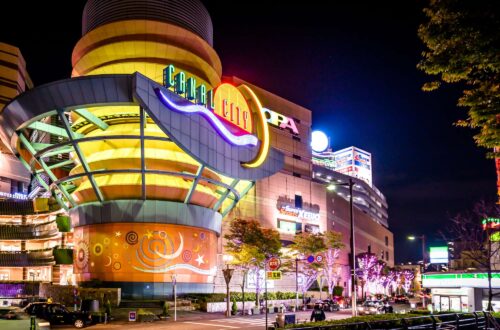
Canal City – A Complete Guide to Fukuoka’s Architecture Marvel
March 5, 2023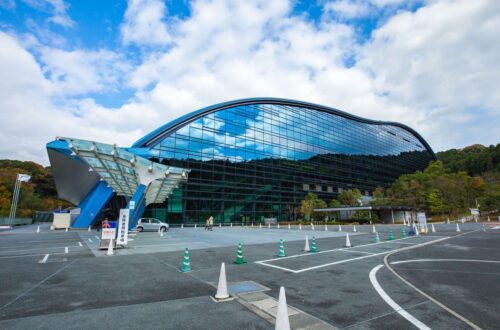
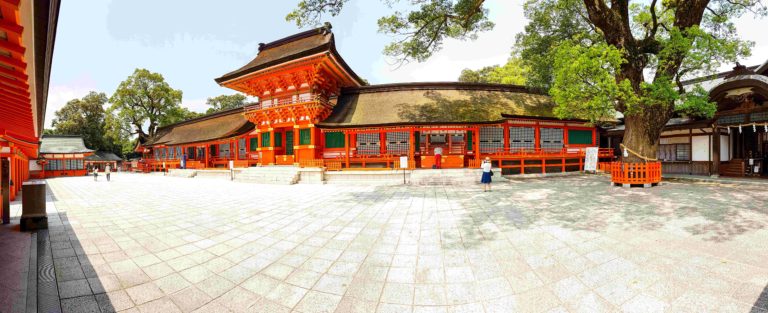

2 Comments
Lenore | The Nitty Gritty Travel OT
Wow, these pictures are enchanting! I felt as if I were there exploring. I find it fascinating that the mountains, rivers, and forests have their own deities. I’d definitely visit, great guide!
Yentravelsjapan
Hi Lenore, thanks for your encouraging comment. Indeed, I too like the idea of how they build the shrine next to the forest and nature. Its like an integration with mother nature =D